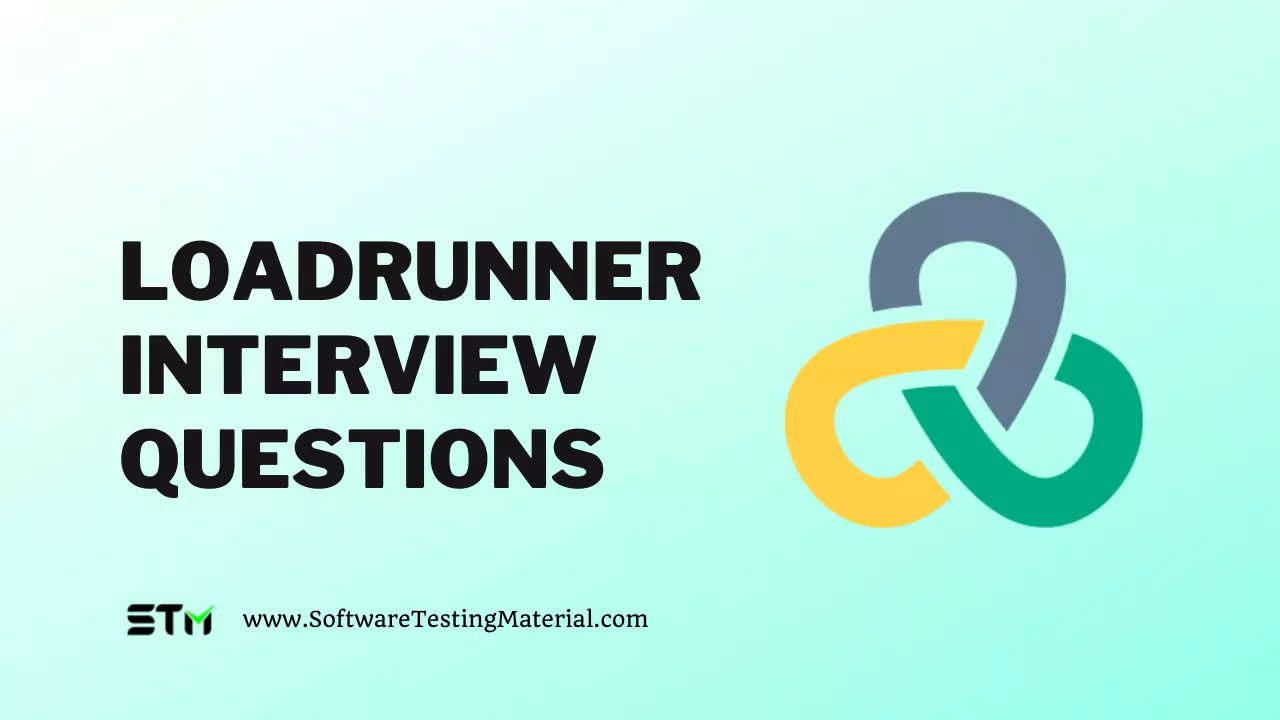90+ LoadRunner Interview Questions & Answers | 2025 Update

Are you ready to ace your upcoming LoadRunner job interview? Wouldn’t it be great if you knew exactly what questions a hiring manager would be asking you in your next LoadRunner Load Testing Interview?
We have covered all the important LoadRunner Interview Questions and Answers in this post.
We have also covered other topics related to you are as follows. Don’t miss to check out.
- Popular JMeter Alternatives
- Best Performance Testing Tools
- Selenium Interview Questions
- Software Testing Interview Questions
- Java Interview Questions For Selenium Automation Testers
- Python Interview Questions For Selenium Testers
- Why you chose Software Testing As Your Career
- Explain Your Selenium Test Automation Framework
Basic & Advanced LoadRunner Interview Questions and Answers:
LoadRunner has become the most popular load and performance testing tool in the load testing space.
No matter you are experienced or freshers, we have covered all levels based on the requests we got from our readers. Here we have covered LoadRunner Interview Questions asked in companies.
Related posts:
#1. What is Load Runner?
Load Runner is a performance testing tool from Micro Focus, widely used for detecting performance bottlenecks in websites.
It is basically used to test the performance and behavior of a system under heavy load.
Loadrunner software can simulate several thousand clients concurrently and test the essential components of software under different conditions.
It not only helps you in testing performance but also helps in improving it.
Testing types, including Load, Stress, Endurance, Volume and Spike Testing are supported by this tool.
#2. What are the advantages of LoadRunner?
Some of the advantages of LoadRunner are as follows
- It reduces the amount of human interaction required.
- Reduces the need for various systems.
- Using automation as effectively as possible
- It allows you to better utilize your time and money.
#3. Explain various components of LoadRunner?
Various components of LoadRunner are as follows:
- Virtual User Generator (VuGen): VuGen captures end-user business processes and generates Vuser script (automated perforamance testing script) that emulate the actions of end-users.
These Vuser Scripts can be used even in other Micro Focus products such as LoadRunner Cloud, Business Process Monitor, and others. - Controller: It creates, executes, manages, and monitors the load tests.
- Load Generator: It is used to generate load.
- Analysis: It is used to view, interpret, and compare the results of the load tests.
#4. Explain Performance Testing Life Cycle?
- Step 1: Perform system analysis and identify critical transactions
Virtual User Generator - Step 2: Create virtual user scripts
- Step 3: Define users behavior
LoadRunner Controller - Step 4: Create load test scenarios
- Step 5: Run the load test scenarios and monitor the performance
LoadRunner Analysis - Step 6: Analyze the results
#5. Name the protocols supported by LoadRunner?
Protocols supported by LoadRunner are as follows.
- .NET Record / Display
- Database
- DCOM
- GUI
- Java Record and replay
- Network
- Oracle E-Business
- Remote desktop
- SAP
- SOA
- Web and Multimedia
- Wireless
- Web 2.0
#6. How to run a test on LoadRunner?
- Planning the Test – includes developing a clearly defined test plan to make sure that the newly developed or the LoadRunner test scenarios can accomplish the load-testing objectives.
- Creating the Vuser scripts – involves Vuser script creation that includes various tasks performed by every Vuser performed during scenario execution.
- Creating the Scenario – this elaborates the events that take place during the client/server testing session. A scenario includes machines, scripts, Vusers, a list of Vuser scripts that the Vusers run during the scenario. Scenarios are created by using LoadRunner Controller. Manual scenarios, as well as goal-oriented scenarios, can also be created.
- Running the Scenario – Here, you can run the entire scenario, Vuser groups, or individual Vusers. Before the testing, load on the server is emulated by instructing multiple Vusers to perform the tasks at the same time.
- Monitoring the performance – Using LoadRuner online run-time, transaction resources, database resources and firewall resources can be monitored.
- Analyzing Test Results – while executing a scenario, LoadRunner records the application’s performance (client/server system) under multiple loads. Its graphs and reports are used to analyze the application’s or server’s output.
#7. What component of LoadRunner can be used to record a Script?
The VuGen (Virual User Generator) component is used to record a script. It allows you to implement Vuser scripts for a variety of application types and communication protocols.
#8. What component of LoadRunner is used to playback a script in multi-user mode?
The Controller component is used to playback the script in multi-user mode. This is done during a scenario run, where a Vuser Script is executed by a number of Vusers in a group.
#9. What do you mean by the Rendezvous point?
Rendezvous point aids in emulating heavy user load (request) on the server.
This instructs Vusers to wait during test execution for multiple Vusers to arrive at a certain point, in order to perform multitasking.
In simple words, its a meeting point betwen transactions.
The significance of this is to simulate a heavy load on a small area of the scenario and observe how the application behaves.
Function lr_rendezvous is utilized to create the Rendezvous point. After script recording, it can be inserted in the script through Insert > Rendezvous.
For example, to emulate peak load on the bank application, you can insert a rendezvous point instructing 1000+ Vusers to deposit cash simultaneously.
#10. What are Vusers and Vuser scripts?
Vuser:
Vusers are the replacement of human users in LoadRunner. Vusers imitate the behavior of real users by executing typical business activities in your application.
During the recording session, the actions that Vuser’s perform aare described in Vuser script. VuGen component is used to generate Vuser scripts.
Vuser Scripts:
It’s the script that controls all of the Vuser’s activities to accomplish a specific goal. When we execute a scenario, every Vuser executes a Vuser script. The application’s performance is also tracked via a function defined in the Vuser script.
#11. How many types of VUsers are available in LoadRunner?
Types of Vusers in LoadRunner are GUI Vuser, DB Vuser, SAP Vuser, Web Vuser, RTE (terminal emulator), People Soft, Java, etc.,
#12. What are the types of Vuser logs and state the differences?
Log files are crucial for troubleshooting the script. The logging of errors is enabled only after a script has been launched.
There are two types of Vuser logs in LoadRunner.
- Standard Logs
- Extended Logs
Standard Logs: During script execution, the standard log creates a log of functions and messages sent to the server.
Extended Logs: However, the extended log captures detailed execution messages including warnings and other messages. It is used during debugging.
#13. How many VUsers are necessary for load testing?
For this there cannot be any generic answer.
The number of VUsers required depends on many aspects such as System Under Test (SUT), Hardware Settings, Network Configurations, Memory, OS, and Objective of the performance test.
#14. What is the difference in running the Vuser as a process and as a thread?
When Vuser is run as a process, the same driver program is loaded into memory for each Vuser. This will consume a lot of RAM and restrict the number of Vusers you can execute on a single generator.
When Vuser is run as a thread, only one instance of the driver program is loaded into memory for the given number of Vusers. The multi-threading mode allows you to run more Vusers on a single generator.
#15. What are the benefits of running Vuser as a thread?
The benefits of running a VUser as a thread are as follows:
Running Vusers as a thread allows for the creation of more virtual users from any memory, since the small memory print of the Vuser running a thread puts it at an advantage.
#16. What are the sections of a Vuser script?
Vugen contain the 3 section .
- Vuser-init – This should be used to record the logon.
- Action – This is used to record the business process.
- Vuser-end – This should be used to record the logoff.
#17. What is the significance of “Vuser-init“ Section?
Before the application actually runs, vuser-init records the pre-operations, also known as the initialization operations.
#18. What is the significance of “Action“ Section?
Action is used to record the business process (clicent activity).
#19. What is the significance of “Vuser-end“ Section?
Vuser-end is used to record a log off in to the server.
#20. What is Ramp up and Ramp Down?
Ramp-up:
The term “ramp up” refers to gradually increasing the amount of load on a server. Increasing the number of Vusers is an example of this. To set Ramp Up, go to ‘Scenario Scheduling Options’.
Ramp-down:
The term “ramp down” refers to gradually decreasing the amount of load on a server. Decreasing the number of Vusers is an example of this.
#21. How to create a Vuser Script?
There are 4 steps for creating a VUser script.
- Record the Vuser Script.
- Playback / Enhance the recorded VUser script.
- Configure the run-time settings
- Incorporate the script in a LoadRunner scenario
#22. How can you set the number of Vusers in LoadRunner?
You may adjust the number of Vusers in the controller section area while creating scenarios. In the controller section there are many sophisticated options such as Vuser ramp-up and ramp-down in addition to this.
#23. What is a Correlation?
Correlation is used to deal with the dynamic values in a test script. The dynamic values may change depending on each user action (value changes when the same user repeats the action) or for different users (value changes when action is replayed with different users). These values are maintained via correlation in both situations, ensuring that they do not break down during execution.
#24. Clarify the difference between Automated and Manual Correlation?
Manual correlation and Automatic correlation.
Manual Correlation:
Manual correlation involves locating the dynamic value, finding the first occurrence of dynamic value, determining the unique boundaries of capturing the dynamic value, and developing a correlation function “web_reg_save_param” before a request that has the first occurrence of dynamic value in its response.
Automatic Correlation:
Automated correlation is based on predefined correlation rules. The script is replayed and inspected for autocorrelation in the event of a failure. Vugen identifies the area where the correlation rules are effective, and the value of approval is correlated.
#25. How Do You Find Out Where Correlation Is Required? Give Few Examples From Your Projects?
There are two ways: Firstly we can look for correlations and examine a list of values that can be correlated. We can choose a value to correlate from this. Secondly, we can record two scripts and compare them. We can look up the difference file to see which values needed to be correlated.
#26. While the script is running and we find that there are some values that need to be correlated? Is it feasible to perform manual correlation on those values?
No. It’s not possible to do correlation when the script is running but we can make changes once the script has stopped.
#27. Assume you have created several Auto Correlation rules. How to provide your Auto Correlation rules to other tester who is working on different work station?
I would export the AutoCorrelation rules to a .cor file and send it to the team mates. Any member in my team can import the .cor file into their Auto Correlation rules.
#28. How is Automated Correlation configured?
Any setting related to Automated Correlation can be set by General Options-> Correlation. Correlation rules are set from Recording options->Correlations.
#29. What is the best way to figure out what to correlate and what to parameterize?
Any occurrences of a value in the script that varies with each iteration or for each user when replaying must be correlated.
When recording, all user input should be parametrized.
#30. What are the different types of goals in Goal-Oriented Scenario of Load Runner?
There are five different types of goals in Goal-Oriented Scenario in LoadRunner.
- The number of concurrent Vusers
- The number of hits per second
- The number of transactions per second
- The number of pages per minute
- The transaction response time
#31. What is a scenario?
The scenario is a description of the events that will take place during each testing session. For example, a scenario specifies and regulates the number of users to emulate, the actions to be performed, and the machines on which virtual users execute their simulations.
#32. How To Create A Scenario?
We need to install a LoadRunner controller on the host. After that, we add the list of the hosts (where vuser script runs), vuser scripts (where vuser executes) and list of vuser that run during the scenario..
#33. How To Run A Scenario?
To run a scenario, first open an existing scenario – Configure the scenario – Set the result directory – Run the scenario.
#34. How many types of scenario in LoadRunner?
There are two types of scenario in LoadRunner
- Manual Scenario
- Goal-oriented Scenario
#35. What is difference between Manual scenario and Goal oriented scenario?
The following are the differences between a Manual scenario and a Goal Oriented scenario:
Manual Scenario: In Manual scenario, the user must specify the ramp up, test duration time, and ramp down. It gives us control over how many Vusers run and at what time.
Goal Scenario: The Goal-Oriented scenario may be created based on the goal you provided, allowing the loadrunner controller to do so. Goal may be throughput, response time, or number of concurrent Vusers.
#36. What is the Think Time? What is the default value of threshold level for think time? How Do You Change The Threshold level of think time?
When a user receives data from a server or other applications, the user may wait some time to review the data before responding. This delay is known as think time.
Think time is the wait time inserted intentionally between the actions in the script to mimic real users’ wait time while working on the application.
The default value of threshold level for think time is five (5) seconds.
The Threshold level for Think time in the level below which recorded think time will be ignored.
The think time threshold can be changed in the Recording options of the VuGen.
Recorded options->Script->Generate think time greater than threshold.
#37. What are the changes we can make in run-time settings?
The changes we can make in the run-time settings are as follows.
- Run Logic – It allows us to arrange your operations in a logical order and set the number of iterations.
- Pacing – It allows us to insert a fixed or random delay between iterations.
- Log – It allows us to set logging as standard or disabled and also lets us define when and what logs to be stored.
- Think time – It allows us to set think time to be fixed or random delay between transactions.
- Miscellaneous – It allows us to do configuration settings related to error handling, multithreading, and automatic transaction.
- Browser – It allows us to configure browser settings like cache.
- Speed simulation – It allows us to configure network speed by setting up bandwidth value.
- Streaming – It allows us to set-up video buffer timeout and retries.
- Content check – It allows us to find known errors in the script while execution.
- Proxy – It allows us to set proxy server.
- Preferences – It allows us to set checkpoint, preformance graph, advanced settings.
- Download Filters – It allows us to filter out unwanted requests coming from any URL or any server.
- Chain configuration – It allows us to configure Data Format Extension during code generation
#38. What is the syntax of Think Time?
The synatax of Think Time is lr_think_time
#39. What is difference between pacing and think time?
Pacing: It is the wait time between the action iterations
Think time: It is the wait time between the transactions.
#40. Which function is used to end a nested transaction?
The function is – lr_end_sub_transaction
#41. What is the difference between transaction and transaction instance in LoadRunner?
Transaction: It is used to measure the time between execution of specific statements.
Transaction instance: It is used for performance analysis of a web application.
#42. What is Elapsed Time in Load Runner?
The elapsed time designates how much time has passed since the start of the current event and is measured differently for various screens as shown below.
Scenario Status window: Elapsed time is measured from the moment you hit “Start Scenario” or ” Initialize/Run Vuser?” button.
“Vuser” window: Elapsed time is measured from the moment Vuser enters “running” state.
#43. What are the types of checkpoints available in LoadRunner?
There are two types of checkpoints in LoadRunner
- Text Checkpoints
- Image Checkpoints
We can add these two checkpoints in VuGen.
#44. What is Image Checkpoint in LoadRunner?
Image Checkpoint confirms the presence of an image on a web page during run-time
#45. What is Text Checkpoint in Loadrunner
Text Checkpoint confirms the presence of a text-string on a web page during run-time
#46. How do you enable text and image checks in VuGen?
By using web_find (for text check) and web_image_check (for image check) functions and also by enabling image and text check from runtime setting.
Run Time Setting >Preference >Enable the Image and text checkbox.
#47. What is the difference between web_reg_find and web_find?
web_reg_find – This function is processed before the request sent and is placed before the request in the VuGen script
web_find – This function is processed after the response of the request comes and is placed after the request in VuGen script.
#48. What we use Checkpoints in LoadRunner?
Sometimes, while running a test, we need to make sure the targeted content is present on the requested page. A content check verifies that the expected information is displayed on the webpage.
#49. What are monitors?
Monitors are used to “monitor” performance bottlenecks.
#50. What are the monitors are available in LoadRunner ?
There are three monitors in LoadRunner
- Application Server Monitor
- Web Server Monitor
- Database Server Monitor
- Network Monitor
#51. How do you identify the performance bottlenecks?
We can identify performance bottlenecks using monitors. Monitors aid in the identification of a problematic area, contributing to increased response times. The test measurements frequently include performance response time, throughput, hits per second, network delay graphs, and so on.
#52. What is Hits Per Second?
Hits Per Second is used to measure how many times your site gets “hit” by people, in other words this is how many times people visit your site in any second.
The number of times a user (or users) sends an HTTP request to the Web server in a second is known as the Hits Per Second.
#53. What is Connection per second?
The number of connections made to the web server by users in each second is known as connections per second.
#54. What is a Transaction?
A group of requests is known as transaction.
#55. What is Transaction per seconds?
The number of transactions completed in a second during load testing.
#56. What is the difference between Hits per second vs Transactions per second?
A single transaction can create multiple hits on the server. A simple login operation involves in many http requests on the webserver and grouping those http requests together is a transaction.
#57. What is Average Response Time?
Average Response Time is the average time the server takes to respond to all the requests given to it.
#58. Define throughput and how it relates to response time?
Throughput is a key metric in performance testing that measures how many requests a software can handle per second, per minute, or hour.
In terms of load/Performance testing. Throughput and Response times are inversely proportional. i.e With increase in Response Time(RT), Throughput(TP) should decrease. With increase in Throughput(TP), Response Time(RT) should decrease.
#59. How you decide the number of load generator machines required to run a test?
The number of load generator machines required would totally depend on two things.
- The protocol which we use to generate the script.
- The configuration of the load generator machine.
Each protocol has its own memory print, which determines how many virtual users can be generated from the machine’s configuration.
#60. How do you identify Performance test use cases of any application?
Writing performance test cases/use cases are similar to functional test cases (manual test cases). We can identify performance test cases from the functional test cases only when the following criteria is met.
- User actions should be linked to the application’s most important and crucial features.
- The user actions should have a lot of database activity, such as search, erase, or add.
- The user volume should be decent.
In Performance testing, the functionality of having less user activity is typically neglected.
A functional test case (manual test case) that satisfies the above criteria can be used as a Performance Testing use case/test case.
If manual test cases aren’t prepared step by step, the Performance team should develop them.
#61. Why do we need to execute performance tests?
Sometimes website crashes, especially during heavy traffic loads. An incident was witnessed with the delayed ticket bookings when IRCTC – Indian railways’ official e-ticketing portal shuts down during lockdown. Many such server overloads have been observed over time.
These performance problems can be resolved through performance tests that ensure the application performs as required irrespective of the traffic, fluctuations in bandwidth availability, and other similar factors.
#62. What aspects of performance testing of a system can improve?
- Speed: With the help of performance testing, we can check the speed before the application goes live.
- Enhance Application Scalability: These tests are highly crucial if you want to add more users to the system. With scalability test, we can easily optimize the response time by adding more users to the database server.
- Enhance Application Stability: The application stability indicates if it can run without any performance degradation. It can be identified by running performance tests like endurance or soak tests.
- Fix Bugs before Application Go-Live: Performance tests ensure the application functions as it is expected. Sometimes bugs may not be identified during initial testing and may appear when the application is tested in a production-like environment. We can find these bugs and fix them during performance testing before the application goes live.
#63. How can you limit Vusers numbers in LoadRunner?
You can limit Vusers numbers in the controller section while creating your scenarios. Many other advanced options like ramp-up, ramp-down of Vusers are also available in the Controller section.
#64. What do you understand by the Modular approach of scripting?
In the modular approach, a function is created for each request like login, logout, etc., and these functions are referred to wherever required.
It gives more freedom to reuse the request and saves time. With this approach, it is recommended to use web custom requests.
#65. What is load testing?
It is the practice of determining the software behavior under normal or high load situations. It is about finding out the error conditions that can affect the expected results of a system, software, application, or product. This testing is basically performed for multi-user systems, web servers, word processors, graphic editors, and so on.
#66. What is Stress Testing?
It is a form of testing that is carried out to determine the capability of an application, product, system, or software to maintain its effectiveness under different conditions. Also known as fatigue testing, the process of stress testing is performed to find out the stability of a system or software under unfavorable conditions. The points on which this process is carried out include the error-handling capacity of software under heavy load, robustness, and reliability.
#67. What is Performance Testing?
It is a form of investigation that is carried out to determine the speed, effectiveness, and efficiency of a system, application, product, or software. Performance testing involves quantitative tests such as measurement of response time, the number of (millions of) instructions per second that a system can execute, reliability assessment, interoperability trial, and scalability testing. It also investigates how fast the software can perform a specific application under a particular workload.
#68. What is concurrent user hits in load testing?
It happens when multiple users, without any time difference, hits on the same server under the load test is called a concurrent user hit. In order to avoid this issue, a concurrency point is added so that multiple Virtual Users can work on the same application without hitting the concurrency point. With the help of this, the virtual users will wait for the other users running the scripts to leave if they reach early. When all the virtual users reach the concurrency point, only then do they start hitting the requests.
#69. What is Concurrent user in load runner ?
Concurrent users refer to all users who are performing various distinct activities on your site.
#70. What is Simultaneous user in load runner ?
Simultaneous users refer to all users working on the same activity at the same time.
#71. How concurrent users are differing from simultaneous users?
All simultaneous users are concurrent users but all concurrent users are not simultaneous users.
In the case of a running scenario, all Vusers are Concurrent users since they’re using the same application at the same time, but they may or may not be performing the same activities. Simultaneous users do the same activity at the same time. Concurrent users can be converted to Simultaneous users by means of rendezvous points.
Rendezvous points instruct the system to wait for a specific number of Vusers to arrive so that they all can do a particular task simultaneously.
#72. Why we perform automated load testing?
We perform automated load testing because
- It is difficult to measure the performance of the application correctly with manual tests.
- Difficult to do synchronization between the users.
- Real-time users are needed for performance testing.
- Difficult to analyze the results & bottlenecks.
- It increases the infrastructure cost.
#73. What is Schedule by Scenario in load runner ?
The same task is done within the group, and then repeated in a separate group is known as Schedule by Scenario.
After you create your script in Vugen, you need to create your scenario in LoadRunner Controller. If you schedule by scenario, both scripts will start at the same time, run for the same duration and tear down at the same time.
#74. What is Schedule by group in loadrunner ?
All users performing various different activities in different groups is known as Schedule by Group.
After you create your script in Vugen, you need to create your scenario in LoadRunner Controller. If you schedule by group, you can set a different schedule for each group and its unique start time, duration and tear down.
#75. What is Test duration time in loadrunner ?
The test duration is the period of time you will be conducting your performance test.
#76. What is the forumla of Test duration time in loadrunner ?
Test duration time is measured in Start and End of the testing.
Test duration time = Actual Start Time – Actual End Time
#77. How to extract a value from a given specified string?
Using lr_eval_string ();
#78. How to extract a value from string to integer in LoadRunner?
Using lr_atoi();
#79. How to extract a value from integer to string in LoadRunner?
Using lr_itoa();
#80. What is Parameterization & why is Parameterization necessary in the script?
Parameterization is the process of replacing hard-coded values in the parameter file within the script.
It allows a single virtual user (Vuser) to utilize multiple sets of data or records on each execution.
It prevents the server from caching results.
#81. What is the difference between lr_error_message and lr_debug _message?
lr_error_message – It sends an error message to the LoadRunner Controller’s Output window.
lr_debug _message – It sends a debug message to the LoadRunner Controller’s Output window.
#82. How do you identify which protocol to use for any application?
The prototype advisor in LoadRunner recognizes the protocols that the application uses and recommends us the possible protocols in which script can be created to simulate the real user.
#83. How is VuGen script modified after recording?
After recording, the script can be modified by following these steps:
- Transaction
- Parameterization
- Correlation
- Variable declarations
- Rendezvous Point
- Validations/Check point
#84. How Loadrunner works?
The LoadRunner operates via 3 different tools – Virtual User Generator (VuGen), Controller, Load Generator, and Results and Analysis Tool.
The Virtual User Generator permits you to regulate what actions you prefer the virtual users (Vusers), to perform under stress within the application. VuGen can be used for recording on windows platforms. VuGen allows a user to create scripts that generate a series of actions to be performed against the application under test and enables the performance tester to playback and make modifications to the script as needed. Load generators are controlled by VuGen scripts which issue non-GUI API calls using the same protocols as the client under test.
#85. Mention the benefits of LoadRunner on testing tools?
The benefit of LoadRunner testing tools are
- Versatility
- Test Results
- Easy Integrations
- Robust reports
- Enterprise Package
#86. Which tests can you perform with LoadRunner?
By using LoadRunner, we can do mainly four types of testing.
- Load Testing
- Stress Testing
- Endurance Testing
- Volume Testing
#87. Mention some languages supported by LoadRunner?
Loadrunner supports six languages C, C#, Java, JavaScript, VB, and VB.NET. The most preferred language for LoadRunner is C. Java is also used based on the protocol used. Loadrunner has its own functions called LoadRunner functions or LR functions. In Loadrunner, different protocols use their own functions; for instance, HTML/HTTP protocol uses web functions.
#88. Explain the visual representation feature of LoadRunner?
One other key feature is that LoadRunner offers is a visual representation of web cases and can be integrated with many different visual inspection components. This tool not only helps users understand their application performance in a real environment but also helps them in understanding and debugging problems in the code during development.
It has an extremely user-friendly and extensible GUI that allows easy navigation and editing of various case properties. Thus, the combination of powerful features, including an easy-to-use graphical user interface and an exhaustive set of performance testing tools, makes it one of the most preferred software testers’ tools in the market today.
#89. What are some unique features of LoadRunner?
LoadRunner has many advanced features that are not available in any other software tools. Some of its unique features include the intelligent user interface, real-time error detection, support for HTTP response codes, unique code-behind error reporting, HTTP response format support, and detailed error reports. These features make Loadrunner one of the most robust and valuable load testing software tools available today.
#90. Name some popular testing solutions for performance testing?
Some of the pouplar performance testing tools are as follows
- WebLOAD
- LoadRunner
- Apache JMeter
- NeoLoad
- StresStimulus
Check this post for detailed list of best performance testing tools
Key Points To Remember:
- Vuser increases – Throughput increases – Hits per second increases – else – all decreases
- Throughput not increasing then it is a Bandwidth issue. A bandwidth issue occurs if Throughput becomes flat while the number of Vusers increases.
- Hits per second not increasing then it is a Web server issue. If Hits per second becomes flat as Vusers increase, there is likely a web server connection problem.
- Throughtput inversely proportional to Response time
- Think Time: Delay b/w any two steps
- Pacetime: Delay b/w iterations
- Rendezvous Point: Meeting points.
- To emulate heavy user load on the server.
- It instructs Vusers to wait during test execution for multiple Vuser to arrive at a certain point, so that they may concurrently perform a task.
What is OpenText LoadRunner Family?
The OpenText LoadRunner Family offers powerful tools and processes that enable seamless collaboration among our teams, helping us outperform traditional solutions. By leveraging widely adopted technologies, the LoadRunner Family promotes continuous collaboration across teams. It provides fully scalable Enterprise coverage, real-time insights, and integrated access to commonly used tools to tackle real-world performance testing challenges.
Let’s take a closer look at the LoadRunner Family solutions:
- LoadRunner Professional: This solution simplifies performance testing for co-located teams by supporting a wide range of protocols and over 50 technologies in application environments.
- LoadRunner Enterprise: As a web-based platform accessible globally, LoadRunner Enterprise centralizes resources to facilitate enterprise-wide performance testing and collaboration.
- LoadRunner Cloud: Test performance at a massive scale with this flexible cloud-based solution that offers simplicity and scalability, making it perfect for seasonal and peak testing.
- LoadRunner Developer: Built into the other LoadRunner solutions, LoadRunner Developer delivers “shift-left” performance testing embedded throughout the development lifecycle.
With the OpenText LoadRunner Family, we can achieve enhanced collaboration, improved performance, and better testing capabilities.
Conclusion – LoadRunner Interview Questions and Answers
I hope that this article on LoadRunner Interview Questions will help you understand the concept better and makes you crack any interview without any hitch. I hope we have covered the most frequently asked LoadRunner Interview Questions here. In case you have any other questions which we didn’t cover here, please ask them in the comments section and we will answer them.
Related Posts:






